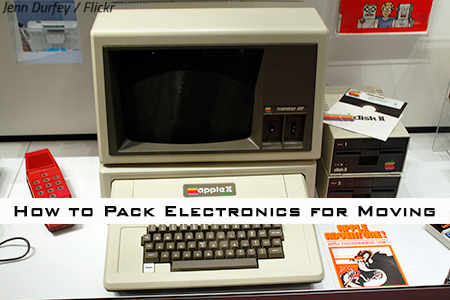 Of all the things that could get damaged when moving, electronics is high on the list and certainly can cause you the most inconvenience, especially if you rely on your laptop, for example, to work from home. And the kids will be none too impressed if their gaming console is damaged during your home move!
Of all the things that could get damaged when moving, electronics is high on the list and certainly can cause you the most inconvenience, especially if you rely on your laptop, for example, to work from home. And the kids will be none too impressed if their gaming console is damaged during your home move!
Knowing how to protect, and how to pack electronics for shipping during your home move whether across town or out of state, is a useful home moving skill to have.
So in this moving blog, we will offer you sound advice on how to pack electronics when moving home.
6 Easy Steps for Packing Electronics for Moving
- Back-up all your electronic files.
- Photograph and label all the cables and corresponding connections.
- Remove ink cartridges from printers, disconnect cables, and bag each components connections together.
- Pack devices into manufacturers’ original packing boxes if available.
- Assemble packing materials of three-ply cardboard boxes, anti-static bubble wrap, wrapping papers, and tape and marker pens.
- Follow our packing guide to ensure the safety of your precious electronics.
Here we go:
- #1 Back Up All Your Electronic Files – Make a copy of any files that you cannot run the risk of losing. Use memory sticks, external data storage, email or internet based secure data storage facilities to keep all your precious files safe. Back them up to two different locations to be sure that they are safe.
- #2 Photograph and label all the cables and corresponding connections – Color coding the cables and the terminals they connect into with small labels will ensure that you know exactly what goes where. An additional label detailing which device the cables belong to is also advisable. So, you should end up with a colored label at each end of the cable, color-coded with the connectors, and a label stating which device the cable belongs to. Photographing the cables whilst in situ is also a good idea as a visual reminder.
- #3 Remove ink cartridges from printers, any batteries, disconnect cables, and bag each components connections together – After labeling all your cables, disconnect them, wrap and then secure with elastic bands or food bag ties to prevent those inevitable tangles. Bag the cables all together so that you know exactly where everything is, but pack them with their respective device so that they do not get mixed up. They can they be safely packed into the moving boxes. Ensure that when in the box they cannot move around and damage the device they are packed with.
- #4 Pack devices into manufacturers’ original packing boxes if available – This is the safest way to transport your precious electronics, especially if you have retained the foam protectors that your items were encased in when new.
- #5 Assemble packing materials if you do not have the original packing. You will need three-ply cardboard boxes as they are the sturdiest, anti-static bubble wrap, wrapping papers, and sealing tape and marker pens. Have plenty of blankets or paper that you can use to fill any spaces in the packing boxes to stop any movement of the contents whilst they are being moved.
See also: Packing timeline for moving
Home Moving Packing Tips for Electronics
The best way to pack electronics for moving is to hire the services of a professional packing and removal company as they will have the skills and correct packaging materials to ensure that your electronics remain safe, but should you decide to pack your precious electronics yourself here are our top packing tips.
-
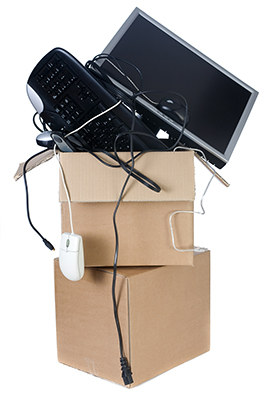
No, this is NOT the correct way to pack electronic devices when moving home.
Prior to packing electronics for travel photograph their condition, make a note of the manufacturer, model number, and any serial numbers. Then produce an electronics packing list so that in the event that you need to make an insurance claim at a later date you will be able to provide all the information the insurance company may require.
- Having labeled and disconnected all the cables, wind the cables so that they do not become a tangled mess and secure in place with a tie such as an elastic band, zip tie or food bag ties.
- Do not place bubble wrap or newspaper directly onto the screens of your electronics as this can damage the screen. Instead cut a piece of card the same size as the screen.
- Wrap the device in soft paper or a blanket. Securely tape so that the protection cannot move whilst being handled.
- Place the cardboard protector that you earlier cut out, over the screen and secure in place with tape.
- Cover the entire thing in bubble wrap or thick blankets and secure again with tape.
- Use 3 ply cardboard boxes to transport your delicate electronics and these offer the best protection for transit and stacking.
- Pad the bottom of the box with a blanket, clothing or bubble wrap which will absorb any impacts when the item is placed on the floor.
- Place the item in the box. Do not stack multiple items on top of each other without an additional layer of protection such as more padding, always ensuring that heavier items are packed in the box first. It is highly recommended though that you pack only one electronic item per box.
- Ensure that the contents of the box cannot move about in transit by filling any gaps with bubble wrap, linens, or newspaper.
- Another layer of padding should be placed on top of the items before securely sealing the box. Seal the box lengthways and from side to side for additional safety.
- Finally clearly label the box as ‘Fragile – Handle With Care – This Way Up’. Ensure you label which room the box is to go into to make it easier for the movers.
- Clearly identify which side of the box the screen is so the movers can take extra care to prevent damage to the screen.
- It is not advisable, for security reasons, to mark on the box that it contains valuable electronic equipment.
- If you are expecting rain on moving day, securely wrap the box in plastic such as bin liners, to keep the box and contents dry. Remember to attach the box labels on the outside of the plastic wrapper as well as on the boxes themselves, so that in the unlikely event that the plastic gets torn off your boxes, they are still well labeled.
Useful: The best packing tips for your move
Money Saving Tip on the easiest way to safely pack a TV: If you have a large TV to move, rather than buying a specific TV box which can be incredibly expensive, around $150 for a carton, check with your local bicycle store if they have any spare bike boxes. These are usually very sturdy and will accommodate most sizes of TV screen. Be sure to pad the TV well to ensure it does not move around inside the box.
Money Saving Tip on how to pack a desktop computer or monitor for moving: If you have a hard shell suitcase these offer a cheap packing solution. When packing electronics in a suitcase be sure to pad each wall of the suitcase with blankets or other protection before placing the electronics inside. Follow the packing tips above on protecting the device before placing in the suitcase.
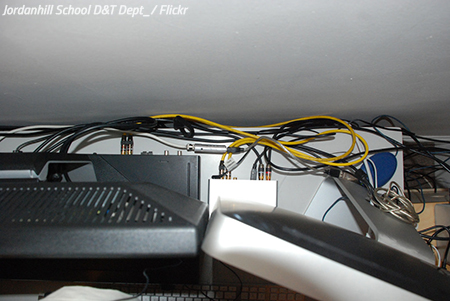
Save loads of post-move time by taking a photo of how your electronic devices are wired up before disconnecting them.
Good Idea: If you are in any doubt about reconnecting any of your devices, you may want to consider downloading the user manual from the internet prior to starting the packing process. Obviously, you will want to do this before you disconnect your computer and printer. Send an electronic copy of the manual to your email address if you can access your emails from your phone. It is also a good idea to save any manufacturer customer helpline numbers to your cell phone in case you need assistance when reassembling your electronics.
Get Insured: Electronics are the some of the most likely things to get damaged when moving home. Check that you are adequately insured to cover the cost of replacement for the item and comply fully with any conditions of your insurance policy. Take the time to ensure that you are covered by insurance for every eventuality. Remember to photograph your electronics before and after packing as they will be useful evidence in the event of an insurance claim.
Be aware: If your home move involves shipping your home contents by air, that your airline may have very specific guidelines for packing electronics for air travel, so please contact them to ensure that you comply with any conditions they may impose. Remember to also check whether you can pack electronics in checked baggage, the more research you do prior to moving day, the fewer surprises and less stressful moving day will be.
Caution #1: Do not use packing peanuts for electronics as they can create static which can cause permanent damage to sensitive electronics. You can, however, buy packing peanuts that have an antistatic coating should you want to use them. The same caution should be applied when using clothing or blankets as a packing material as fleece material especially can cause static.
Caution #2: If you plan on using a storage facility for your household and electronic goods consider if the storage needs to be climate controlled. It is best to discuss this with the storage company to determine if their facilities are suitable for the type of electronics you will wish to store.
Security tip #1: If you have very expensive or irreplaceable electronics you may want to consider attaching a tracking device to the item before packing. These are fairly inexpensive now and means you can track the exact location of your items from an app on your smartphone.
Security tip #2: Whilst many people have one password for many devices, or a fairly weak password for a computer that is always in the home, you are about to remove your computer from the safety of your home. It is a good idea to change your passwords for every device so that each one has a different password. In the very unlikely event that your device or computer does get stolen when moving home, you will be safe in the knowledge that you have protected each item with a secure password. Just remember to store the passwords safely so that you know what they are for each device!
Must-read: Common packing mistakes to avoid
Unpacking Sensitive Electronic Equipment
- Unpack your electronics carefully, checking that no small connectors or cables have gotten missed in the discarded packing materials. Do not dispose of any packing materials until every cable and connector is accounted for.
-
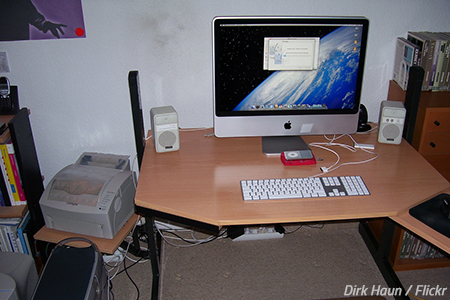
You’d hate to see any of your expensive electronic devices damaged during the move, wouldn’t you? Follow our tips for packing electronics to stay safe.
Having moved home, especially in the hotter or colder months of the years, allow at least 24 hours for your sensitive electronics to adjust to their new environment, this will prevent condensation forming within the device which can ultimately cause corrosion.
- Reconnecting your electronics should be straightforward if you have labeled and photographed them properly, but most manufacturers have help lines should you need them.
- Test each device is working properly before reconnecting the next device, that way if there is a problem, it will be easier to troubleshoot.
Hiring a professional packing and moving company can actually be very cost effective, especially if embarking upon a long-distance interstate move. They will have the skills and correct packing materials to ensure that your electronics arrive in your new home in the same condition that they left your old home. It is entirely free to get a quote from a reputable moving company and could save you plenty of heartache and expense if your improperly packaged items get damaged.
Should come in handy: 10 tips for hiring movers

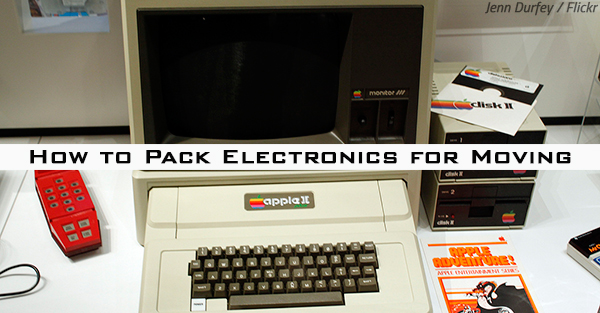







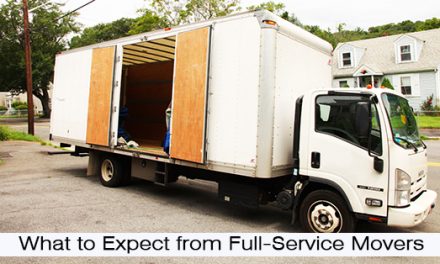
The tips mentioned above are good however things can become very messy if one is not used to all this. Under such a situation it is better to consider the services of a professional moving company.